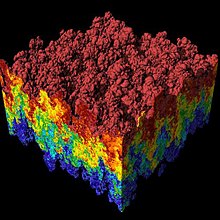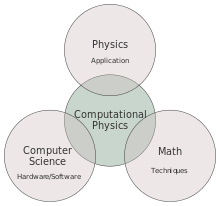Computational physics
| Computational physics |
|---|
 |
Computational physics is the study and implementation of numerical analysis to solve problems in physics.[1] Historically, computational physics was the first application of modern computers in science, and is now a subset of computational science. It is sometimes regarded as a subdiscipline (or offshoot) of theoretical physics, but others consider it an intermediate branch between theoretical and experimental physics — an area of study which supplements both theory and experiment.[2]
Overview

In physics, different theories based on mathematical models provide very precise predictions on how systems behave. Unfortunately, it is often the case that solving the mathematical model for a particular system in order to produce a useful prediction is not feasible. This can occur, for instance, when the solution does not have a closed-form expression, or is too complicated. In such cases, numerical approximations are required. Computational physics is the subject that deals with these numerical approximations: the approximation of the solution is written as a finite (and typically large) number of simple mathematical operations (algorithm), and a computer is used to perform these operations and compute an approximated solution and respective error.[1]
Status in physics
There is a debate about the status of computation within the scientific method.[4] Sometimes it is regarded as more akin to theoretical physics; some others regard computer simulation as "computer experiments",[4] yet still others consider it an intermediate or different branch between theoretical and experimental physics, a third way that supplements theory and experiment. While computers can be used in experiments for the measurement and recording (and storage) of data, this clearly does not constitute a computational approach.
Challenges in computational physics
Computational physics problems are in general very difficult to solve exactly. This is due to several (mathematical) reasons: lack of algebraic and/or analytic solvability,
Methods and algorithms
Because computational physics uses a broad class of problems, it is generally divided amongst the different mathematical problems it numerically solves, or the methods it applies. Between them, one can consider:
- root finding (using e.g. Newton-Raphson method)
- system of linear equations (using e.g. LU decomposition)
- ordinary differential equations (using e.g. Runge–Kutta methods)
- integration (using e.g. Romberg method and Monte Carlo integration)
- partial differential equations (using e.g. finite difference method and relaxation method)
- matrix eigenvalue problem (using e.g. Jacobi eigenvalue algorithm and power iteration)
All these methods (and several others) are used to calculate physical properties of the modeled systems.
Computational physics also borrows a number of ideas from computational chemistry - for example, the density functional theory used by computational solid state physicists to calculate properties of solids is basically the same as that used by chemists to calculate the properties of molecules.
Furthermore, computational physics encompasses the
Divisions
It is possible to find a corresponding computational branch for every major field in physics:
- Computational mechanics consists of computational fluid dynamics (CFD), computational solid mechanics and computational contact mechanics.
- electromagnetic fields with physical objects and the environment. One subfield at the confluence between CFD and electromagnetic modelling is computational magnetohydrodynamics.
- quantum many-body problem.
- Computational material science.
- Computational condensed matter which deals with the simulation of models and theories (such as percolation and spin models) that are difficult to solve otherwise.
- Computational social sciences, network theory, and mathematical models for the propagation of disease (most notably, the SIR Model) and the spread of forest fires.
- Numerical relativity is a (relatively) new field interested in finding numerical solutions to the field equations of both special relativity and general relativity.
- Computational particle physics deals with problems motivated by particle physics.
- Computational astrophysics is the application of these techniques and methods to astrophysical problems and phenomena.
- Computational biophysics is a branch of biophysics and computational biologyitself, applying methods of computer science and physics to large complex biological problems.
Applications
Due to the broad class of problems computational physics deals, it is an essential component of modern research in different areas of physics, namely:
Computational solid state physics, for example, uses
See also
- Advanced Simulation Library
- CECAM - Centre européen de calcul atomique et moléculaire
- Division of Computational Physics (DCOMP) of the American Physical Society
- Important publications in computational physics
- Mathematical and theoretical physics
- Open Source Physics, computational physics libraries and pedagogical tools
- Timeline of computational physics
- Car–Parrinello molecular dynamics
References
- ^ a b
Thijssen, Jos (2007). Computational Physics. ISBN 978-0521833462.
- ^
Landau, Rubin H.; Páez, Manuel J.; Bordeianu, Cristian C. (2015). Computational Physics: Problem Solving with Python. John Wiley & Sons.
- ^
Landau, Rubin H.; Paez, Jose; Bordeianu, Cristian C. (2011). A survey of computational physics: introductory computational science. ISBN 9780691131375.
- ^ a b A molecular dynamics primer Archived 2015-01-11 at the Wayback Machine, Furio Ercolessi, University of Udine, Italy. Article PDF Archived 2015-09-24 at the Wayback Machine.
- S2CID 124545445. Article PDF
- ^
Sauer, Tim; Grebogi, Celso; Yorke, James A (1997). "How Long Do Numerical Chaotic Solutions Remain Valid?". Physical Review Letters. 79 (1): 59–62. S2CID 102493915.
Further reading
- A.K. Hartmann, Practical Guide to Computer Simulations, World Scientific (2009)
- International Journal of Modern Physics C (IJMPC): Physics and Computers Archived 2004-11-03 at the Wayback Machine, World Scientific
- Steven E. Koonin, Computational Physics, Addison-Wesley (1986)
- T. Pang, An Introduction to Computational Physics, Cambridge University Press (2010)
- B. Stickler, E. Schachinger, Basic concepts in computational physics, ISBN 9783319024349.
- E. Winsberg, Science in the Age of Computer Simulation. Chicago: University of Chicago Press, 2010.
External links
- C20 IUPAP Commission on Computational Physics Archived 2015-11-15 at the Wayback Machine
- American Physical Society: Division of Computational Physics
- Institute of Physics: Computational Physics Group Archived 2015-02-13 at the Wayback Machine
- SciDAC: Scientific Discovery through Advanced Computing
- Open Source Physics
- SCINET Scientific Software Framework
- Computational Physics Course with youtube videos

